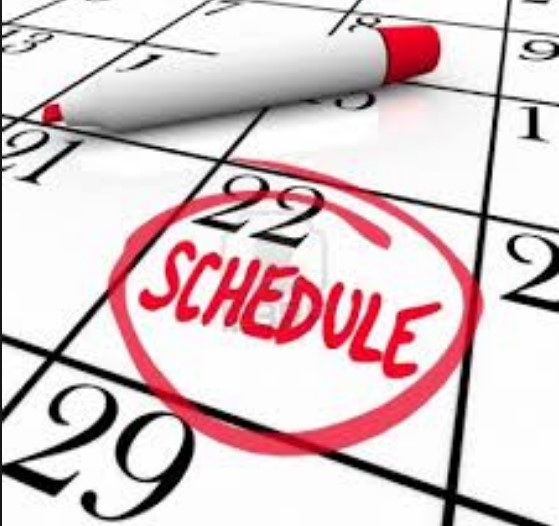The foolproof way to become a scheduler and get things done.
Have you struggled with scheduling your days and actually sticking to that schedule?
That’s too bad, because scheduling your days are the only real way to fit everything into a 24 hour period.
Here’s your guide to time blocking/scheduling your day.

Step one: Choose your scheduling tool.
Google Calendar is a good option. Apple has their own calendar too.
You can go the BulletJournal route, which will let you be a bit more creative.
I like Cal Newport’s option. If you don’t want to spend money on the Black n’ Red Twin Wire notebook he references, you can substitute a legal pad.
I recently found a journal by Best Self, which I am really enjoying.
Since I find it easier to compartmentalize, I use Cal Newport’s method at work and the Best Self journal for my personal goals.
Unless you use a computer a lot, I recommend going the analog route.
You need to be able to easily adjust your schedule as things change. In my experience this is more easily done with a pen and paper.
Plus, notebooks don’t need to be charged.

Step two: Pick your time block increment.
Elon Musk uses 5 minute increments. For those of us not running two companies, this is a bit excessive.
I recommend starting with 60 minute increments and adjusting from there.
When you set aside an hour for everything, it’s hard to over schedule and, consequently, overwhelm yourself.
That being said, feel free to choose whatever increment you want. Again, you’ll probably need to adjust this increment after scheduling for a few days.
Currently, I default everything to 60 minutes. However, I cut certain tasks down to 30 or 15 minutes.
Google Calendar defaults to 60 minutes, but you can change that in the settings.

Step three: Add your “unchangeables.”
Add the tasks you can’t change. They don’t have to occur everyday, but if you can’t skip it, add it first.
“The chief task in life is simply this: to identify and separate matters so that I can say clearly to myself which are externals not under my control, and which have to do with the choices I actually control. Where then do I look for good and evil? Not to uncontrollable externals, but within myself to the choices that are my own . . .”
— Epictetus, Discourses, 2.5.4–5
Start with the most obvious task you complete everyday: Sleep.

You can tackle this in two ways.
- How much sleep do you want to get?
- What time do you want to get up?
Both of these involve aspects of the other, but focus on the one that matters more to you.
If you want to get up at 4:00 am, make that your focal point. If you’ve been trying to get more sleep, make that your focal point.
No matter which one you choose, you’ll end up asking yourself the same questions.
For example, if you want to get up at 4 the first thing you’ll mark on your calendar will be, “4:00 AM — Wake up.”
The next question you’ll ask yourself is, “What time will I need to go to sleep, so I can get up at 4:00 AM and not feel like a zombie all day?” So, the question within the question is, “how much sleep do I need to get?” See how similar that is to #1?
If you’re trying to get a certain amount of sleep, then I’m guessing that the time you wake up is less important to you. However, feel free to choose both options. Your schedule is your oyster!
As any sleep expert will tell you, it’s better to go to bed and wake up at the same time each day, even on the weekends. So, try to make this time consistent each day.
If you want some help getting out of bed in the morning, I wrote another article, which goes into a bit more detail:

If you’re like me, you have a day job, and you need this schedule to stay focused outside of your 9–5.
Thus, the next uncontrollable event is work.
This one is pretty straight forward. Block off the eight hours a day you work and don’t forget to include your lunch break.

Going right along with your day job and uncontrollable things, how do you get to work?
Add your commute to your calendar.
Be sure to overestimate here. If you only schedule 15 minutes, but occasionally hit 20 minutes of traffic, you’re setting yourself up to have a bad day.
Obviously, you can adjust this as you become more familiar with traffic patterns.

Step four: Add your most important tasks.
Now that you’ve added everything you have to do, you can start adding the tasks required to meet your personal goals.
Start with the same increment you chose at the beginning, but then you need to ask yourself some questions.
First, how long will this task take?
Overestimate all of your tasks, you’ll see why in step five.
Second, will I feel up to it at this time/after doing whatever tasks comes before it?
If you eat a whole pizza, and then try to read Moby Dick in one sitting, you’ll be asleep in 20 minutes.
You need to be aware of how energetic you are throughout the day and factor this into your schedule. For more on this read, The Power of Full Engagement.
Third, do I need to all of this in the same day?
Jack Dorsey creates a theme for each day. However, most of the discussions about success out there talk about daily habits.
But, maybe you need to create an environment that allows you to complete Deep Work.
For example, I’ve found that when I schedule time for writing, I end up engrossing myself in it for more than my allotted hour (today, I’m approaching hour two).
Obviously this won’t work for every task, but give it a try and see if you’re able to get more done.

Step five: Using your schedule.
The biggest rule is to make your schedule work, which means two things:
- Adjust every detail of this process, until it’s easy for you.
- Schedule things you enjoy.
When I first started scheduling my days, I felt constricted by all the things I had to do and the times they started and ended.
Be liberal with your schedule.
The key to this system is the time increment you chose in step one. By scheduling everything for 60 minutes, you can easily move the blocks of time around as needed.
If you scheduled 60 minutes to workout at 6 am, but wake up late, you can switch it with the 60 minutes of TV you scheduled at 6 pm.
The same goes for your energy levels. If you wake up at 6 am, but want to write instead of working out, switch those slots. Then, when you create your schedule for the next day, consider switching these two permanently.
Furthermore, if you schedule a workout from 6 am — 7 am, but finish at 6:45 am, you now have 15 minutes of free time.
Address this by inserting something fun, or starting the next task early.
Either way, you’ll end up with 15 minutes of breathing room. If this happens twice in one day, you now have 30 minutes of free time, which you can fill with whatever you want.
Don’t let this stop you from scheduling things you enjoy.
If you schedule an hour of TV, you can use it as a throwaway task, in case you wake up late. But, more importantly, you need breaks scheduled in to stay sane.

Wrapping things up (yes, I did!):
I created this system by reading tons of articles and books on productivity and scheduling. Ultimately, you’ll need to adjust the details to fit your life.
Don’t be too hard on yourself. You might have to throw away an entire day.
That is fine.
Make sure you get back to scheduling the next day.
Make sure you’re constantly adjusting until it works.
“I have not failed. I’ve just found 10,000 ways that won’t work.” — Thomas A. Edison
